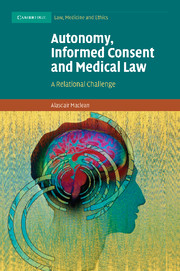Book contents
- Frontmatter
- Contents
- Table of cases
- List of figures
- Acknowledgements
- Introduction
- Part I An ethical model
- 1 Autonomy
- 2 The relevance of beneficence, justice and virtue
- 3 The healthcare professional–patient relationship: Setting the context for consent
- 4 The concept of consent: What it is and what it isn't
- Part II Consent and the law
- Summary and conclusion
- Bibliography
- Index
3 - The healthcare professional–patient relationship: Setting the context for consent
Published online by Cambridge University Press: 02 July 2009
- Frontmatter
- Contents
- Table of cases
- List of figures
- Acknowledgements
- Introduction
- Part I An ethical model
- 1 Autonomy
- 2 The relevance of beneficence, justice and virtue
- 3 The healthcare professional–patient relationship: Setting the context for consent
- 4 The concept of consent: What it is and what it isn't
- Part II Consent and the law
- Summary and conclusion
- Bibliography
- Index
Summary
A model must incorporate respect for the personhood and self-determination of the patient and should enhance dialogue between the two parties of the relationship.
P. G. Smith and L. H. Newton, ‘Physician and patient’ (1984)Consent is not unique to healthcare and, while it may serve parallel functions in different contexts, the regulation of consent should be sensitive to the setting. For example, the requirements for a valid consent in the context of non-commercial sexual relationships are influenced by the necessary absence of formality, which is not the case for consent to healthcare interventions. Furthermore, because consent must always involve at least two agents it is not a free-floating device that can exist in the absence of a relationship. The way healthcare professionals approach consent indicates their attitude towards their patients, which should reflect a moral sensitivity to the issues discussed in the first two chapters, and is central to the relationship between them and their patients. The patient's role in the relationship is equally important and the way in which the patient approaches consent will impact on the effectiveness of the communicative process and the consent decision that results. Thus, it is important to situate consent within the context of the relationship between the patient and the healthcare professional.
Positing consent as central to the professional–patient relationship emphasises its communal aspect.
- Type
- Chapter
- Information
- Autonomy, Informed Consent and Medical LawA Relational Challenge, pp. 72 - 109Publisher: Cambridge University PressPrint publication year: 2009



